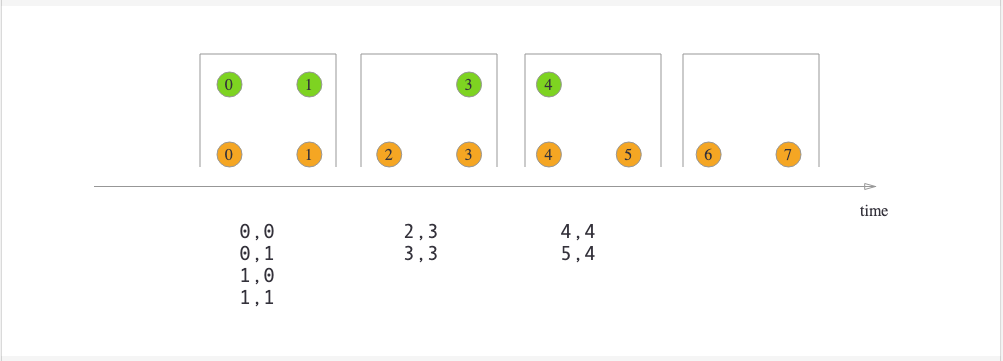来源:https://mp.weixin.qq.com/s/vTAkUrPfO4DW1qOzJ-Zs4A
在数据库中的静态表上做 OLAP 分析时,两表 join 是非常常见的操作。同理,在流式处理作业中,有时也需要在两条流上做 join 以获得更丰富的信息。Flink DataStream API 为用户提供了3个算子来实现双流 join,分别是:
- join()
- coGroup()
- intervalJoin()
本文举例说明它们的使用方法,顺便聊聊比较特殊的 interval join 的原理。
1 准备数据
从 Kafka 分别接入点击流和订单流,并转化为 POJO。
DataStream<String> clickSourceStream = env .addSource(new FlinkKafkaConsumer011<>( "ods_analytics_access_log", new SimpleStringSchema(), kafkaProps ).setStartFromLatest()); DataStream<String> orderSourceStream = env .addSource(new FlinkKafkaConsumer011<>( "ods_ms_order_done", new SimpleStringSchema(), kafkaProps ).setStartFromLatest()); DataStream<AnalyticsAccessLogRecord> clickRecordStream = clickSourceStream .map(message -> JSON.parseObject(message, AnalyticsAccessLogRecord.class)); DataStream<OrderDoneLogRecord> orderRecordStream = orderSourceStream .map(message -> JSON.parseObject(message, OrderDoneLogRecord.class));
2 join()
join() 算子提供的语义为"Window join",即按照指定字段和(滚动/滑动/会话)窗口进行 inner join,支持处理时间和事件时间两种时间特征。
以下示例以10秒滚动窗口,将两个流通过商品 ID 关联,取得订单流中的售价相关字段。

clickRecordStream .join(orderRecordStream) .where(record -> record.getMerchandiseId()) .equalTo(record -> record.getMerchandiseId()) .window(TumblingProcessingTimeWindows.of(Time.seconds(10))) .apply(new JoinFunction<AnalyticsAccessLogRecord, OrderDoneLogRecord, String>() { @Override public String join(AnalyticsAccessLogRecord accessRecord, OrderDoneLogRecord orderRecord) throws Exception { return StringUtils.join(Arrays.asList( accessRecord.getMerchandiseId(), orderRecord.getPrice(), orderRecord.getCouponMoney(), orderRecord.getRebateAmount() ), ' '); } }) .print().setParallelism(1);
简单易用。
3 coGroup()
只有 inner join 肯定还不够,如何实现 left/right outer join 呢?答案就是利用 coGroup() 算子。它的调用方式类似于 join() 算子,也需要开窗,但是 CoGroupFunction 比 JoinFunction 更加灵活,可以按照用户指定的逻辑匹配左流和/或右流的数据并输出。
以下的例子就实现了点击流 left join 订单流的功能,是很朴素的 nested loop join 思想(二重循环)。
clickRecordStream .coGroup(orderRecordStream) .where(record -> record.getMerchandiseId()) .equalTo(record -> record.getMerchandiseId()) .window(TumblingProcessingTimeWindows.of(Time.seconds(10))) .apply(new CoGroupFunction<AnalyticsAccessLogRecord, OrderDoneLogRecord, Tuple2<String, Long>>() { @Override public void coGroup(Iterable<AnalyticsAccessLogRecord> accessRecords, Iterable<OrderDoneLogRecord> orderRecords, Collector<Tuple2<String, Long>> collector) throws Exception { for (AnalyticsAccessLogRecord accessRecord : accessRecords) { boolean isMatched = false; for (OrderDoneLogRecord orderRecord : orderRecords) { // 右流中有对应的记录 collector.collect(new Tuple2<>(accessRecord.getMerchandiseName(), orderRecord.getPrice())); isMatched = true; } if (!isMatched) { // 右流中没有对应的记录 collector.collect(new Tuple2<>(accessRecord.getMerchandiseName(), null)); } } } }) .print().setParallelism(1);
4 intervalJoin()
join() 和 coGroup() 都是基于窗口做关联的。但是在某些情况下,两条流的数据步调未必一致。例如,订单流的数据有可能在点击流的购买动作发生之后很久才被写入,如果用窗口来圈定,很容易 join 不上。所以 Flink 又提供了"Interval join"的语义,按照指定字段以及右流相对左流偏移的时间区间进行关联,即:
right.timestamp ∈ [left.timestamp + lowerBound; left.timestamp + upperBound]

interval join 也是 inner join,虽然不需要开窗,但是需要用户指定偏移区间的上下界,并且只支持事件时间。
示例代码如下。注意在运行之前,需要分别在两个流上应用 assignTimestampsAndWatermarks() 方法获取事件时间戳和水印。
clickRecordStream .keyBy(record -> record.getMerchandiseId()) .intervalJoin(orderRecordStream.keyBy(record -> record.getMerchandiseId())) .between(Time.seconds(-30), Time.seconds(30)) .process(new ProcessJoinFunction<AnalyticsAccessLogRecord, OrderDoneLogRecord, String>() { @Override public void processElement(AnalyticsAccessLogRecord accessRecord, OrderDoneLogRecord orderRecord, Context context, Collector<String> collector) throws Exception { collector.collect(StringUtils.join(Arrays.asList( accessRecord.getMerchandiseId(), orderRecord.getPrice(), orderRecord.getCouponMoney(), orderRecord.getRebateAmount() ), ' ')); } }) .print().setParallelism(1);
由上可见,interval join 与 window join 不同,是两个 KeyedStream 之上的操作,并且需要调用 between() 方法指定偏移区间的上下界。如果想令上下界是开区间,可以调用 upperBoundExclusive()/lowerBoundExclusive() 方法。
interval join 的实现原理
以下是 KeyedStream.process(ProcessJoinFunction) 方法调用的重载方法的逻辑。
public <OUT> SingleOutputStreamOperator<OUT> process( ProcessJoinFunction<IN1, IN2, OUT> processJoinFunction, TypeInformation<OUT> outputType) { Preconditions.checkNotNull(processJoinFunction); Preconditions.checkNotNull(outputType); final ProcessJoinFunction<IN1, IN2, OUT> cleanedUdf = left.getExecutionEnvironment().clean(processJoinFunction); final IntervalJoinOperator<KEY, IN1, IN2, OUT> operator = new IntervalJoinOperator<>( lowerBound, upperBound, lowerBoundInclusive, upperBoundInclusive, left.getType().createSerializer(left.getExecutionConfig()), right.getType().createSerializer(right.getExecutionConfig()), cleanedUdf ); return left .connect(right) .keyBy(keySelector1, keySelector2) .transform("Interval Join", outputType, operator); }
可见是先对两条流执行 connect() 和 keyBy() 操作,然后利用 IntervalJoinOperator 算子进行转换。在 IntervalJoinOperator 中,会利用两个 MapState 分别缓存左流和右流的数据。
private transient MapState<Long, List<BufferEntry<T1>>> leftBuffer; private transient MapState<Long, List<BufferEntry<T2>>> rightBuffer; @Override public void initializeState(StateInitializationContext context) throws Exception { super.initializeState(context); this.leftBuffer = context.getKeyedStateStore().getMapState(new MapStateDescriptor<>( LEFT_BUFFER, LongSerializer.INSTANCE, new ListSerializer<>(new BufferEntrySerializer<>(leftTypeSerializer)) )); this.rightBuffer = context.getKeyedStateStore().getMapState(new MapStateDescriptor<>( RIGHT_BUFFER, LongSerializer.INSTANCE, new ListSerializer<>(new BufferEntrySerializer<>(rightTypeSerializer)) )); }
其中 Long 表示事件时间戳,List<BufferEntry<T>> 表示该时刻到来的数据记录。当左流和右流有数据到达时,会分别调用 processElement1() 和 processElement2() 方法,它们都调用了 processElement() 方法,代码如下。
@Override public void processElement1(StreamRecord<T1> record) throws Exception { processElement(record, leftBuffer, rightBuffer, lowerBound, upperBound, true); } @Override public void processElement2(StreamRecord<T2> record) throws Exception { processElement(record, rightBuffer, leftBuffer, -upperBound, -lowerBound, false); } @SuppressWarnings("unchecked") private <THIS, OTHER> void processElement( final StreamRecord<THIS> record, final MapState<Long, List<IntervalJoinOperator.BufferEntry<THIS>>> ourBuffer, final MapState<Long, List<IntervalJoinOperator.BufferEntry<OTHER>>> otherBuffer, final long relativeLowerBound, final long relativeUpperBound, final boolean isLeft) throws Exception { final THIS ourValue = record.getValue(); final long ourTimestamp = record.getTimestamp(); if (ourTimestamp == Long.MIN_VALUE) { throw new FlinkException("Long.MIN_VALUE timestamp: Elements used in " + "interval stream joins need to have timestamps meaningful timestamps."); } if (isLate(ourTimestamp)) { return; } addToBuffer(ourBuffer, ourValue, ourTimestamp); for (Map.Entry<Long, List<BufferEntry<OTHER>>> bucket: otherBuffer.entries()) { final long timestamp = bucket.getKey(); if (timestamp < ourTimestamp + relativeLowerBound || timestamp > ourTimestamp + relativeUpperBound) { continue; } for (BufferEntry<OTHER> entry: bucket.getValue()) { if (isLeft) { collect((T1) ourValue, (T2) entry.element, ourTimestamp, timestamp); } else { collect((T1) entry.element, (T2) ourValue, timestamp, ourTimestamp); } } } long cleanupTime = (relativeUpperBound > 0L) ? ourTimestamp + relativeUpperBound : ourTimestamp; if (isLeft) { internalTimerService.registerEventTimeTimer(CLEANUP_NAMESPACE_LEFT, cleanupTime); } else { internalTimerService.registerEventTimeTimer(CLEANUP_NAMESPACE_RIGHT, cleanupTime); } }
这段代码的思路是:
- 取得当前流 StreamRecord 的时间戳,调用 isLate() 方法判断它是否是迟到数据(即时间戳小于当前水印值),如是则丢弃。
- 调用 addToBuffer() 方法,将时间戳和数据一起插入当前流对应的 MapState。
- 遍历另外一个流的 MapState,如果数据满足前述的时间区间条件,则调用 collect() 方法将该条数据投递给用户定义的 ProcessJoinFunction 进行处理。collect() 方法的代码如下,注意结果对应的时间戳是左右流时间戳里较大的那个。
private void collect(T1 left, T2 right, long leftTimestamp, long rightTimestamp) throws Exception { final long resultTimestamp = Math.max(leftTimestamp, rightTimestamp); collector.setAbsoluteTimestamp(resultTimestamp); context.updateTimestamps(leftTimestamp, rightTimestamp, resultTimestamp); userFunction.processElement(left, right, context, collector); }
4 调用 TimerService.registerEventTimeTimer() 注册时间戳为 timestamp + relativeUpperBound 的定时器,该定时器负责在水印超过区间的上界时执行状态的清理逻辑,防止数据堆积。注意左右流的定时器所属的 namespace 是不同的,具体逻辑则位于 onEventTime() 方法中。
@Override public void onEventTime(InternalTimer<K, String> timer) throws Exception { long timerTimestamp = timer.getTimestamp(); String namespace = timer.getNamespace(); logger.trace("onEventTime @ {}", timerTimestamp); switch (namespace) { case CLEANUP_NAMESPACE_LEFT: { long timestamp = (upperBound <= 0L) ? timerTimestamp : timerTimestamp - upperBound; logger.trace("Removing from left buffer @ {}", timestamp); leftBuffer.remove(timestamp); break; } case CLEANUP_NAMESPACE_RIGHT: { long timestamp = (lowerBound <= 0L) ? timerTimestamp + lowerBound : timerTimestamp; logger.trace("Removing from right buffer @ {}", timestamp); rightBuffer.remove(timestamp); break; } default: throw new RuntimeException("Invalid namespace " + namespace); } }
本文转载自简书,作者:LittleMagic
原文链接:https://www.jianshu.com/p/45ec888332df